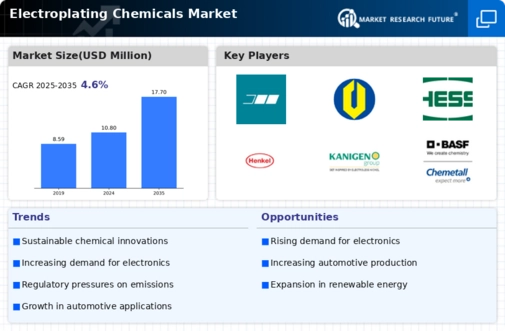Electroplating Chemicals Market is characterized by a high level of competition, with many players emerging for market share. The top 30 companies in the market account for a significant market share of Electroplating Chemicals Market. The competitive landscape of Electroplating Chemicals Market is dynamic, with companies constantly innovating and expanding their product offerings. Despite the challenges, there are several factors that are driving growth in the electroplating chemicals Market. These include growing Demand from renewable energy Industry and expanding Electronics Industry.
The Electroplating Chemicals Market is expected to witness significant growth in the coming years, owing to the expansion of the electronics and renewable energy industry.
The key players in the Electroplating Chemicals Market include Conventya, Schlotter, Uyemura, Hesse, Henkel, Kanigen, Chemetall, Ishihara, Technic, Umicore, JetChem, Houghton, Mosses Lake, KPM, Metalor, HSO, JPC, Meltex, Dipsol, Coral, Ato, Mac, Okuno, JASCO, Sutrec, PAVCO, JCU, Dow, and Columbia Chemical among others. These companies compete based on product quality, innovation, price, customer service, and market share. Companies also engage in various strategic initiatives, such as mergers and acquisitions, new product launches, partnerships, joint ventures, and expansions, to enhance their market position and expand their product portfolio.
Companies are also focusing on developing new and innovative products that meet the specific needs of their customers.
Coventya: Coventya is a prominent global provider of specialty chemicals, primarily focused on the surface finishing industry. Established as a leader in developing innovative chemical solutions, Coventya operates in over 60 countries across five continents, catering to a diverse range of industrial sectors including automotive, electronics, construction, consumer goods, and aerospace. The company specializes in providing both decorative and functional coatings that enhance the performance and aesthetic qualities of various substrates. Coventya's product portfolio includes advanced chemical formulations designed for electroplating, electroless plating, and surface treatment processes.
These products are integral to industries that require high-quality finishes and durability in their components.
Dr. Hesse GmbH & Cie KG: Dr. Hesse GmbH & Cie KG is a renowned chemical company specializing in the development and distribution of electroplating additives and related chemical solutions. Established over 130 years ago, the company has built a solid reputation for innovation in electrochemical deposition technologies. Headquartered in Germany, Dr. Hesse operates on a global scale, catering to a diverse clientele across various industries. The company's product portfolio includes a wide range of electroplating additives designed for different applications. These products encompass hot and electrolytic degreasing agents, pickling solutions, activators, sealing agents, passivation products, and corrosion protection chemicals.
Dr. Hesse is particularly noted for its advanced formulations that enhance the quality and durability of electroplated surfaces, making them suitable for demanding environments.






























